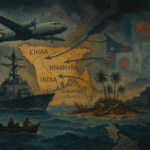Pakistan is India’s primary rival on land. China, though, is a competition that it must contend with at sea. Tensions between India and China, which led to a war in 1962, have their roots in boundary disputes in the Himalayas. However, China has also recently stepped up its presence in the Indian Ocean, which India considers a traditional sphere of influence. To defend its interests, China has built a series of projects collectively referred to as the “String of Pearls,” involving ports in numerous nations that border India. China has established that its initiatives in the Indian Ocean are solely commercial and part of the Maritime Silk Road.
Many Indian and American commentators are suspicious of China’s assertion that its engagement in the Indian Ocean is solely economic and that these projects are a segment of the Maritime Silk Road under its Belt and Road Initiative. India is greatly concerned about China’s close economic and military ties with Pakistan.
With the expansion of its economy over the past ten years, India has gone from being a recipient of help to a provider. Given Afghanistan’s strategic location bordering Pakistan, India views Afghanistan as a critical partner and is now one of the main contributors to Afghanistan. India also invests in the energy sector in Bhutan and Nepal.
Policymakers should watch for signs that might foreshadow Chinese plans to carry out such missions. These include new platforms for maritime-based intelligence collection against state adversaries, efforts to increase the resilience of logistics networks that would be crucial to maintaining operations in a conflict environment, and certain types of naval deployments that exceed the requirements of counterpiracy or humanitarian activities.







I don’t think the title of your article matches the content lol. Just kidding, mainly because I had some doubts after reading the article.
Thank you very much for sharing, I learned a lot from your article. Very cool. Thanks.
Thanks for sharing. I read many of your blog posts, cool, your blog is very good. https://accounts.binance.com/register?ref=P9L9FQKY
Can you be more specific about the content of your article? After reading it, I still have some doubts. Hope you can help me.
Your article helped me a lot, is there any more related content? Thanks!
Can you be more specific about the content of your article? After reading it, I still have some doubts. Hope you can help me.
I don’t think the title of your article matches the content lol. Just kidding, mainly because I had some doubts after reading the article. https://www.binance.info/el/register?ref=DB40ITMB
Can you be more specific about the content of your article? After reading it, I still have some doubts. Hope you can help me.